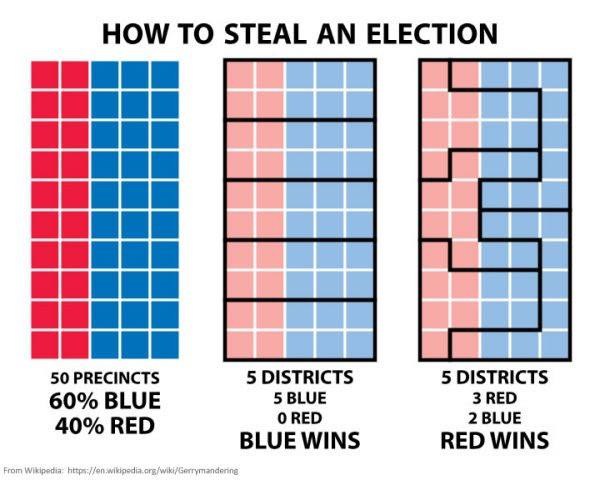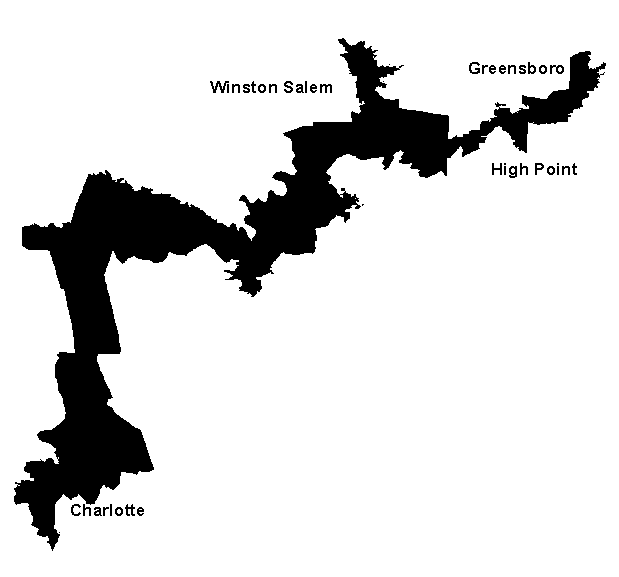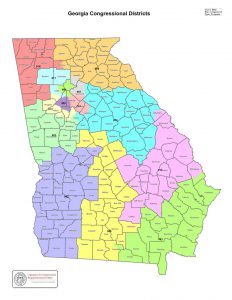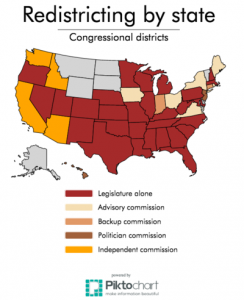“Late in 1788, just after Virginia voted to ratify the Constitution and join the union, former Governor Patrick Henry persuaded the state legislature to remake the Fifth Congressional District, forcing Henry’s political enemy James Madison to run against the formidable James Monroe. The ploy failed and Madison won anyway, eventually becoming the nation’s fourth president. Monroe’s career wasn’t over, though: He succeeded Madison as president.” (From the Library of Congress.)
By Elliott Brack, editor and publisher | Gerrymandering.
 It’s a menace to democracy, awkward, unnatural, outlandish, usually circuitous and often a patchwork, difficult to envision. Right now, however, it’s within the law, and its outcomes are hard to understand.
It’s a menace to democracy, awkward, unnatural, outlandish, usually circuitous and often a patchwork, difficult to envision. Right now, however, it’s within the law, and its outcomes are hard to understand.
I’m talking about some of the nation’s 435 Congressional districts.
The term “gerrymandering” has been around since the early days of our nation. Today’s hard-nosed Congressional manipulators make sure that the Congressional districts are often drawn to favor one particular party. It can happen in any of the states, with the political party in power when the lines are being redrawn being the culprit, trying to squeeze out for the next 10 years the opposing party.
 Some observers say that such gerrymandering amounts to the politicians picking their voters, instead of the people picking their politicians. By squeezing more votes from one party into a concentrated zone, the picking party can maintain control of its Congressional seats better.
Some observers say that such gerrymandering amounts to the politicians picking their voters, instead of the people picking their politicians. By squeezing more votes from one party into a concentrated zone, the picking party can maintain control of its Congressional seats better.
Therefore, the way the district lines are drawn is often crooked, unwieldy, unsightly, sometimes pits natural enemies in the same district, and causes great confusion among voters as to the district in which they reside.
Take a look at North Carolina District 12 (below). Now for the life of me, I can’t tell you whether it is represented by a Republican, Democrat or Independent. This District extends from Guilford County in the north (Greensboro and High Point area) to Charlotte in Mecklenburg County, is strange. Just look at the district map again. Does this look like a naturally-formed district, with constituents having similar overall interests, other than Interstate 85?
 Luckily, we in Georgia don’t have such unusually-drawn districts as some states. About Georgia’s worst is David Scott’s 13th District, which stretches from parts of Henry County westward including parts of Clayton, Fulton, Douglas counties and part of Cobb. At least these are in the same metro area, where the North Carolina District 12 has portions of Greensboro, Winston-Salem and Charlotte within its borders.
Luckily, we in Georgia don’t have such unusually-drawn districts as some states. About Georgia’s worst is David Scott’s 13th District, which stretches from parts of Henry County westward including parts of Clayton, Fulton, Douglas counties and part of Cobb. At least these are in the same metro area, where the North Carolina District 12 has portions of Greensboro, Winston-Salem and Charlotte within its borders.
 Understand, recently the Democrats have particularly been hurt by gerrymandering, as more state legislatures (which often draws the district lines) have been controlled by Republicans. But the GOP doesn’t have a strangle hold on gerrymandering. Both parties try to use it to their benefit. It needs to be outlawed.
Understand, recently the Democrats have particularly been hurt by gerrymandering, as more state legislatures (which often draws the district lines) have been controlled by Republicans. But the GOP doesn’t have a strangle hold on gerrymandering. Both parties try to use it to their benefit. It needs to be outlawed.
Some 37 states let the legislature draw the lines. Four states have independent commissions, and nine states have advisory, back-up or political groups drawing the lines. (Ballotpedia.)
 Meanwhile, Democrats, hurt most recently by Republican gerrymandering, have enlisted former Attorney General Eric Holder Jr. to lead the fight against Congressional gerrymandering. He anticipates attacking this effort through the courts; on the campaign trail; and through ballot referendums. It could prove to be a major effort seeking to bring more order back to government.
Meanwhile, Democrats, hurt most recently by Republican gerrymandering, have enlisted former Attorney General Eric Holder Jr. to lead the fight against Congressional gerrymandering. He anticipates attacking this effort through the courts; on the campaign trail; and through ballot referendums. It could prove to be a major effort seeking to bring more order back to government.
Attacking gerrymandering is not an easy operation. Right now the focus will be on the redrawing of lines in 2022, after the 2020 census determines state populations. But with so many Congressmen in safe seats, even a successful anti-gerrymandering operation may not make great strides until 2032. (Many of us won’t be around to see this campaign come to victory.)
Gerrymandering: today it’s worse than you think.
- Have a comment? Send to: elliott@brack.net










Follow Us